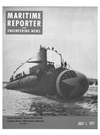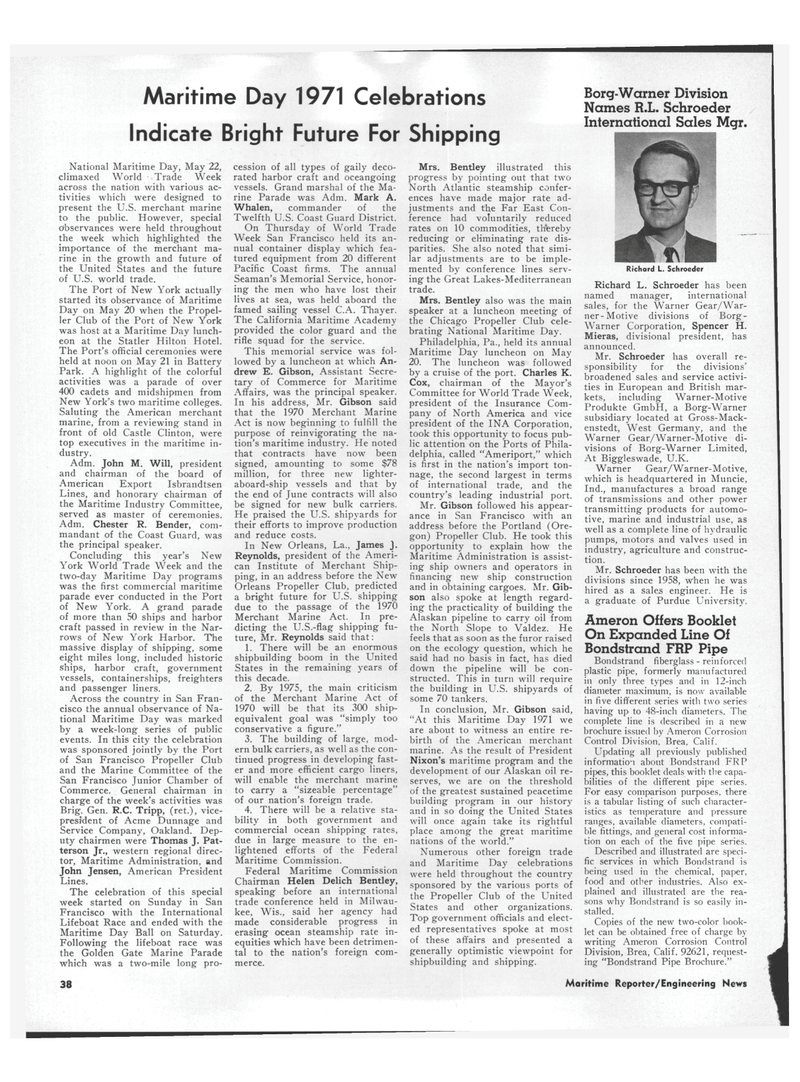
Page 3rd Cover: of Maritime Reporter Magazine (July 1971)
Read this page in Pdf, Flash or Html5 edition of July 1971 Maritime Reporter Magazine
Maritime Day 1971 Celebrations
Indicate Bright Future For Shipping
National Maritime Day, May 22, climaxed World Trade Week across the nation with various ac- tivities which were designed to present the U.S. merchant marine to the public. However, special observances were held throughout the week which highlighted the importance of the merchant ma- rine in the growth and future of th« United States and the future of U.S. world trade.
The Port of New York actually started its observance of Maritime
Day on May 20 when the Propel- ler Club of the Port of New York was host at a Maritime Day lunch- eon at the Statler Hilton Hotel.
The Port's official ceremonies were held at noon on May 21 in Battery
Park. A highlight of the colorful activities was a parade of over 400 cadets and midshipmen from
New York's two maritime colleges.
Saluting the American merchant marine, from a reviewing stand in front of old Castle Clinton, were top executives in the maritime in- dustry.
Adm. John M. Will, president and chairman of the board of
American Export Isbrandtsen
Lines, and honorary chairman of the Maritime Industry Committee, served as master of ceremonies.
Adm. Chester R. Bender, com- mandant of the Coast Guard, was the principal speaker.
Concluding this year's New
York World Trade Week and the two-day Maritime Day programs was the first commercial maritime parade ever conducted in the Port of New York. A grand parade of more than 50 ships and harbor craft passed in review in the Nar- rows of New York Harbor. The massive display of shipping, some eight miles long, included historic ships, harbor craft, government vessels, containerships, freighters and passenger liners.
Across the country in San Fran- cisco the annual observance of Na- tional Maritime Day was marked by a week-long series of public events. In this city the celebration was sponsored jointly by the Port of San Francisco Propeller Club and the Marine Committee of the
San Francisco Junior Chamber of
Commerce. General chairman in charge of the week's activities was
Brig. Gen. R.C. Tripp, (ret.), vice- president of Acme Dunnage and
Service Company, Oakland. Dep- uty chairmen were Thomas J. Pat- terson Jr., western regional direc- tor, Maritime Administration, and
John Jensen, American President
Lines.
The celebration of this special week started on Sunday in San
Francisco with the International
Lifeboat Race and ended with the
Maritime Day Ball on Saturday.
Following the lifeboat race was the Golden Gate Marine Parade which was a two-mile long pro- cession of all types of gaily deco- rated harbor craft and oceangoing vessels. Grand marshal of the Ma- rine Parade was Adm. Mark A.
Whalen, commander of the
Twelfth U.S. Coast Guard District.
On Thursday of World Trade
Week San Francisco held its an- nual container display which fea- tured equipment from 20 different
Pacific Coast firms. The annual
Seaman's Memorial Service, honor- ing the men who have lost their lives at sea, was held aboard the famed sailing vessel C.A. Thayer.
The California Maritime Academy provided the color guard and the rifle squad for the service.
This memorial service was fol- lowed by a luncheon at which An- drew E. Gibson, Assistant Secre- tary of Commerce for Maritime
Affairs, was the principal speaker.
In his address, Mr. Gibson said that the 1970 Merchant Marine
Act is now beginning to fulfill the purpose of reinvigorating the na- tion's maritime industry. He noted that contracts have now been signed, amounting to some $78 million, for three new lighter- aboard-ship vessels and that by the end of June contracts will also be signed for new bulk carriers.
He praised the U.S. shipyards for their efforts to improve production and reduce costs.
In New Orleans, La., James J.
Reynolds, president of the Ameri- can Institute of Merchant Ship- ping, in an address before the New
Orleans Propeller Club, predicted a bright future for U.S. shipping due to the passage of the 1970
Merchant Marine Act. In pre- dicting the U.S.-flag shipping fu- ture, Mr. Reynolds said that: 1. There will be an enormous shipbuilding boom in the United
States in the remaining years of this decade. 2. By 1975, the main criticism of the Merchant Marine Act of 1970 will be that its 300 ship- equivalent goal was "simply too conservative a figure." 3. The building of large, mod- ern bulk carriers, as well as the con- tinued progress in developing fast- er and more efficient cargo liners, will enable the merchant marine to carry a "sizeable percentage" of our nation's foreign trade. 4. There will be a relative sta- bility in both government and commercial ocean shipping rates, due in large measure to the en- lightened efforts of the Federal
Maritime Commission.
Federal Maritime Commission
Chairman Helen Delich Bentley, speaking before an international trade conference held in Milwau- kee, Wis., said her agency had made considerable progress in erasing ocean steamship rate in- equities which have been detrimen- tal to the nation's foreign com- merce.
Mrs. Bentley illustrated this progress by pointing out that two
North Atlantic steamship confer- ences have made major rate ad- justments and the Far East Con- ference had voluntarily reduced rates on 10 commodities, thereby reducing or eliminating rate dis- parities. She also noted that simi- lar adjustments are to be imple- mented by conference lines serv- ing the Great Lakes-Mediterranean trade.
Mrs. Bentley also was the main speaker at a luncheon meeting of the Chicago Propeller Club cele- brating National Maritime Day.
Philadelphia, Pa., held its annual
Maritime Day luncheon on May 20. The luncheon was followed by a cruise of the port. Charles K.
Cox, chairman of the Mayor's
Committee for World Trade Week, president of the Insurance Com- pany of North America and vice president of the INA Corporation, took this opportunity to focus pub- lic attention on the Ports of Phila- delphia, called "Ameriport," which is first in the nation's import ton- nage, the second largest in terms of international trade, and the country's leading industrial port.
Mr. Gibson followed his appear- ance in San Francisco with an address before the Portland (Ore- gon) Propeller Club. He took this opportunity to explain how the
Maritime Administration is assist- ing ship owners and operators in financing new ship construction and in obtaining cargoes. Mr. Gib- son also spoke at length regard- ing the practicality of building the
Alaskan pipeline to carry oil from the North Slope to Valdez. He feels that as soon as the furor raised on the ecology question, which he said had no basis in fact, has died down the pipeline will be con- structed. This in turn will require the building in U.S. shipyards of some 70 tankers.
In conclusion, Mr. Gibson said, "At this Maritime Day 1971 we are about to witness an entire re- birth of the American merchant marine. As the result of President
Nixon's maritime program and the development of our Alaskan oil re- serves, we are on the threshold of the greatest sustained peacetime building program in our history and in so doing the United States will once again take its rightful place among the great maritime nations of the world."
Numerous other foreign trade and Maritime Day celebrations were held throughout the country sponsored by the various ports of the Propeller Club of the United
States and other organizations.
Top government officials and elect- ed representatives spoke at most of these affairs and presented a generally optimistic viewpoint for shipbuilding and shipping.
Borg-Warner Division
Names R.L. Schroeder
International Sales Mgr. •§ m
Richard L. Schroeder
Richard L. Schroeder has been named manager, international sales, for the Warner Gear/War- ner-Motive divisions of Borg-
Warner Corporation, Spencer H.
Mieras, divisional president, has announced.
Mr. Schroeder has overall re- sponsibility for the divisions' broadened sales and service activi- ties in European and British mar- kets, including Warner-Motive
Produkte GmbH, a Borg-Warner subsidiary located at Gross-Mack- enstedt, West Germany, and the
Warner Gear/Warner-Motive di- visions of Borg-Warner Limited,
At Biggleswade, U.K.
Warner Gear/Warner-Motive, which is headquartered in Muncie,
Ind., manufactures a broad range of transmissions and other power transmitting products for automo- tive, marine and industrial use, as well as a complete line of hydraulic pumps, motors and valves used in industry, agriculture and construc- tion.
Mr. Schroeder has been with the divisions since 1958, when he was hired as a sales engineer. He is a graduate of Purdue University.
Ameron Offers Booklet
On Expanded Line Of
Bondstrand FRP Pipe
Bondstrand fiberglass - reinforced plastic pipe, formerly manufactured in only three types and in 12-inch diameter maximum, is now available in five different series with two series having up to 48-inch diameters. The complete line is described in a new brochure issued by Ameron Corrosion
Control Division, Brea, Calif.
Updating all previously published information about Bondstrand FRP pipes, this booklet deals with the capa- bilities of the different pipe series.
For easy comparison purposes, there is a tabular listing of such character- istics as temperature and pressure ranges, available diameters, compati- ble fittings, and general cost informa- tion on each of the five pipe series.
Described and illustrated are speci- fic services in which Bondstrand is being used in the chemical, paper, food and other industries. Also ex- plained and illustrated are the rea- sons why Bondstrand is so easily in- stalled.
Copies of the new two-color book- let can be obtained free of charge by writing Ameron Corrosion Control
Division, Brea, Calif. 92621, request- ing "Bondstrand Pipe Brochure." 38 Maritime Reporter/Engineering News

 31
31

 4th Cover
4th Cover
